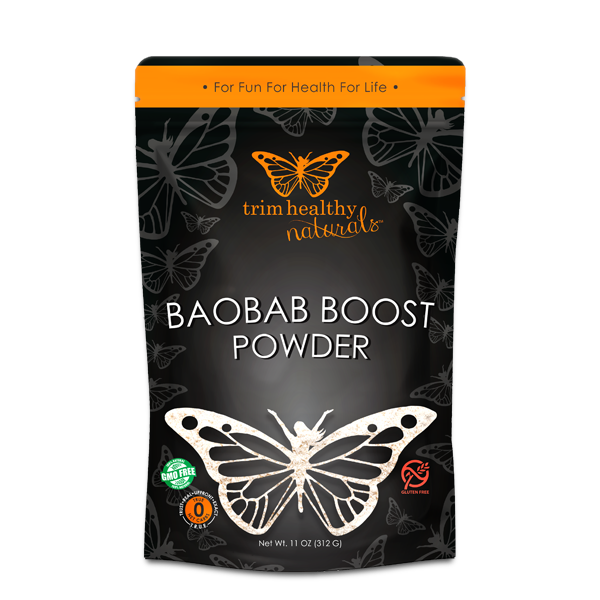Baobab! The Tree of Life
Baobab fruit powder is an incredibly healthy food/supplement to add to your daily routine-SIP IT SLOWLY OVER HOURS LIKE AN IV DRIP!
Adansonia digitata (Baobab)
The baobab tree is considered the Tree of Life, and some say it is what the Bible refers to as the Tree of Life. It is said that these trees have been on Earth for over 200 million years! They can live as long as 5000 years, which is incredible. The baobab tree thrives in 32 African countries, even in arid places. It provides shelter, food, and water, making it the “Tree of Life” in African stories. The largest baobab tree, the Sagole Big Tree in South Africa, is enormous, measuring 60.6 square meters at its base and 19.8 meters tall. The trees shed their leaves for eight months and grow new ones in the dry season. This helps them save water and live in dry places. They can store up to 136,400 liters of water in their trunks and branches. I could go on about the historical significance of the baobab tree, but I think you’ll be more interested in a shorter article that cuts to the chase.
Baobab should not be classified as a supplement but rather as food. Its medicinal uses are virtually unknown outside of Africa. Baobab powder is a rich source of vitamin C, which we all know has many health benefits, including enhancing immune function. It is also almost 50% fiber, half insoluble and half soluble, making it a powerful prebiotic and contains more antioxidants than any other whole fruit (Carlsen M.H.,2010). Since baobab is a food and not a capsule supplement, it is more bioavailable than manufactured vitamin supplements. Our bodies can absorb the nutrients found in Adansonia digitata powder more easily.
Scott Marlsand, a very wise and compassionate provider at Leading Edge Clinic, wrote an article about baobab about a year ago, and I think it’s worth your time to read it. I suggest you become a subscriber to Scott's Substack. According to Scott, baobab’s constituents block the spike protein from entering your cells and can help with micro-clotting.
Baobab pulp is high in vitamin C, antioxidants, and several key minerals like potassium, magnesium, iron, and zinc. It also contains ECGC (Epigallocatechin gallate), which makes it a powerful antioxidant, antiangiogenic, and antitumor agent. ECGC is why people drink green tea unless, of course, you like the taste of green tea, which I do not (though I do drink it sometimes for its ECGC). ECGC is the healthiest component of green tea. Baobab also contains significant amounts of vitamin B6, niacin, iron, potassium, magnesium, and calcium.
Since part of the baobab fruit powder is a resistant starch, it is an amazing pre-biotic. Everyone loves to talk about probiotics, but most fail to realize the importance of pre-biotics. It’s one thing to supplement with probiotics, which can be helpful in the short term, but in my opinion, pre-biotics are more critical, as they provide your gut with what it needs to produce the bacteria that is lacking. These pre-biotics feed the good bacteria! By now, you probably know that having a good and diverse gut biome is extremely important to your health. There is a reason why they say your gut is your second brain. As much as 95% of your serotonin and 50% of your dopamine is produced in your gut, and this production is entirely dependent on your gut having appropriate diversity. If you don’t have a properly diverse gut biome, your immune system and general health will not be as robust as it could be.
Use caution and start slow!
When I first started using baobab, I put a tablespoon in a glass, mixed it in 8 ounces of water, and slammed it down. Wrong idea! The prebiotics in it caused my gut biome to change dramatically overnight, and I became constipated. I know—too much information. Since then, after learning that lesson, I’ve taken Scott Marsland’s advice and begun a ‘sipping’ regime with my baobab intake.
I would advise starting with a teaspoon of the powder mixed in 16 ounces of water and sipping slowly over at least eight hours. This is like giving yourself an IV drip of the planet's most amazing and healthful food. Do this for a week or two and gradually increase your consumption to one tablespoon daily. You can mix it in cold water or do as I do and mix it in hot/warm water and drink it like tea. (of course, it will cool down throughout the day and become a room-temperature drink, which is fine). Baobab has an interesting and unique flavor. I wouldn’t say it’s delicious, but it really doesn’t taste bad. It has a bit of a citrusy flavor that I’ve come to enjoy. (Note: If you plan on drinking your baobab mixture cold or at room temp, I know that a lot of people choose to use a 'shaker bottle' which can be purchased online on Amazon, Walmart, or many other merchants)
There are several merchants out there that supply baobab powder, but I choose to get mine from Trim Healthy Mama, but they’re currenly sold out. Another great option for purchasing baobab powder is from Tiiga.
From the Trim Healthy Mama product page:
Baobab fruit boosts your nutrition in every area. Its citrus and sherbet-tasting dried flesh has five times the fiber of oats and higher antioxidant levels than any food on the planet (8 times that of the super berry Acai and more than both blueberries and pomegranates combined!) It has more than twice the calcium of milk, double the magnesium and iron of spinach, and is loaded with six times the potassium of bananas. Recent studies reveal that baobab is a significant source of ECGC (Epigallocatechin Gallate), a unique plant compound that has been shown to reduce inflammation, aid weight loss, and help prevent heart and brain disease as well as act as an anti-cancer agent.
Most importantly, Baobab Boost is a delicious way of boosting your vitamin C. Having a rich supply of this vitamin is a huge game changer when it comes to losing weight. Vitamin C-depleted people are resistant to fat loss. Clinical studies show those with adequate vitamin C levels oxidize 30% more fat during exercise than individuals with low levels. Plainly put, vitamin C helps prevent weight gain and makes it easier to lose it. It also improves blood sugar levels and supports adrenal health (adrenal-depleted people are often resistant to fat loss). Vitamin C also enables proteins such as collagen and gelatin to work more effectively and safely in your body.
AI Search for Baobab Health Benefits
I typically don’t trust any AI Al Gore Rhythm, but I believe their description of baobab’s health benefits is spot on:
Baobab fruit has several health benefits, including:
Supplying important nutrients
Aiding weight loss
Balancing blood sugar levels
Reducing inflammation
Optimizing digestive health
Supporting heart health
Boosting the immune system
Promoting healthy skin
Preventing diabetes
Supporting healthy pregnancy
Treating brain diseases such as Dementia, Alzheimer’s disease, and Parkinson’s disease.
I hijacked the following information from Z Natural Foods.
What are the health benefits of Baobab Powder?
Baobab fruits are well known to be a quality source of polyphenolic compounds.
The following was stated in an article in Applied Sciences discussing the bioactive Compounds and Scavenging Capacity of Baobab Fruit Pulp Extracts against ROS and RNS of Physiological Relevance.
The pulp of baobab fruit is acknowledged to be a valued source of phenolic compounds like rutin, quercetin, catechin, gallic acid, and proanthocyanins.
Baobab pulp contains more polyphenols and vitamin C than similar commonly eaten fruits (kiwis, strawberries, oranges, and apples).
However, the baobab fruit also has two specific benefits that stand out:
1) Resistant Starch
Baobab fruit, along with green bananas and unripe papayas, belongs to a unique group of foods known as resistant starches. These are dietary starches that do not break down into sugar and resist digestion in the small intestines. Instead, they pass through most of the digestive system unchanged, ending up in the colon, where they ferment and feed the microbiota. This unique property of resistant starches specifically benefits gut health, creating a cascade of incredible effects on overall well-being.
The following was stated in a randomized controlled study examining the effects of baobab fruit on reducing starch digestion and glycemic response in humans. “All extracts in this study were good sources of polyphenols. Baobab fruit extract added to white bread at 1.88 % significantly (P < .05) reduced rapidly digestible starch from white bread samples.”
2) Prebiotics
We can’t speak about resistant starches and gut health without delving into prebiotics and the potential that baobab has shown in preliminary studies. This area of study is consistently evolving as the list of foods containing these various fibers grows.
Furthermore, what was once believed to be a component of insoluble fiber is now also seen in soluble fibers. To be considered prebiotic, dietary carbohydrates must
Resist gastric acidity, gastrointestinal enzymes, and absorption
Get fermented by intestinal probiotic microflora
Selectively stimulate the growth and activity of probiotics.
Baobab is building strong evidence to fit the bill as a prebiotic food.
After reading this article, I hope you will do a little research on your own and consider starting a baobab ‘sipping’ regimen. Stay healthy, folks! Arm yourselves with the knowledge necessary to overcome the desires of the evil cabal.
If you have questions, please leave them down below in the comments section of this article.







Do you know if there is anything that is synergistic with it? Lemon, olive leaf? I'm using some in salad dressing.